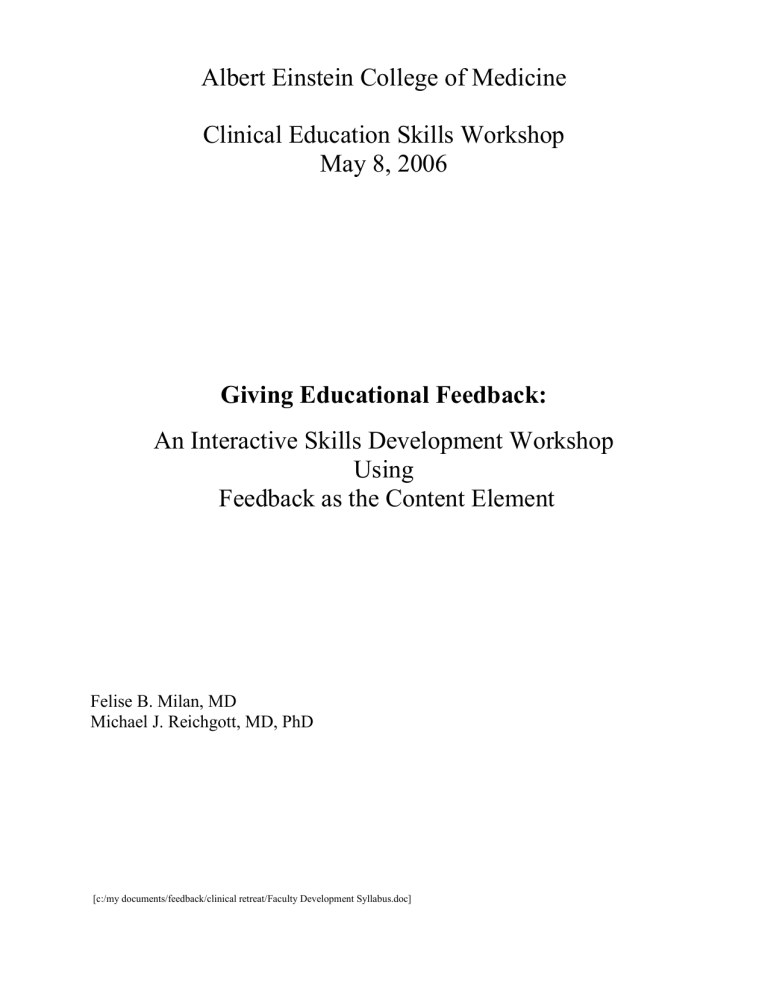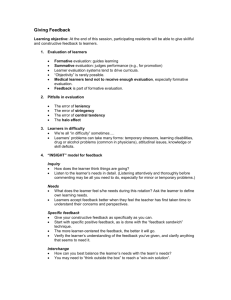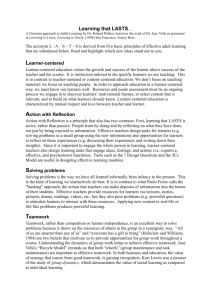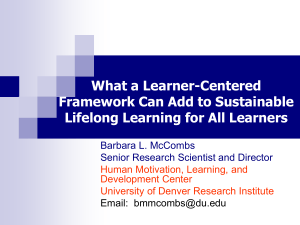Feedback Syllabus - Albert Einstein College of Medicine

Albert Einstein College of Medicine
Clinical Education Skills Workshop
May 8, 2006
Giving Educational Feedback:
An Interactive Skills Development Workshop
Using
Feedback as the Content Element
Felise B. Milan, MD
Michael J. Reichgott, MD, PhD
[c:/my documents/feedback/clinical retreat/Faculty Development Syllabus.doc]
Table of Contents
The Theoretical Basis for Learner-Centered Learning
.................................................................. 6
Purpose of the Workshop
For clinical faculty and residents, the skill of constructive feedback is an important educational resource. Providing training in the use of constructive, formative feedback is an important responsibility of clinical education leaders.
Small-group teaching sessions (workshops) on topics intended to provide the participating learners with specific skills can be enhanced by using
“learner-centered” techniques ( i.e.
identifying motivation, interest, and readiness to learn), and by fostering an interactive environment to increase the engagement of the participants and enhance the outcomes. Ideas gleaned from a variety of psychological and educational theories underlay this approach, and simple techniques derived from these theories can be used to present a learner-centered, interactive workshop.
These materials are intended to provide an introduction to learner-centered methods, using formative feedback as the content element. Upon completion of this “train-the-trainer” session, the participants should be able to develop and implement learner-centered, interactive workshops at their own clinical sites. These site workshops may be to train residents (and faculty) in the skills of formative feedback. The workshop methods also can be used for the presentation of any skills, educational or clinical.
Educational Goals
1.
Train faculty in educational methods for developing a workshop on giving feedback to medical students.
2.
Demonstrate a model of interactive small group skills teaching.
3.
Demonstrate use of supportive educational materials for a feedback workshop.
4.
Present content elements pertaining to the use of formative feedback in medical education.
Objectives
Participants will:
1.
Know the elements of giving feedback.
2.
Demonstrate the skills of giving formative feedback using interactive methods.
3.
Initiate a plan to develop a workshop at his/her site using the educational materials provided.
1
Conceptual Model for Interactive Learning
1
Teacher
Context
Content
Learner
Teaching Context: the setting in which the teaching takes place.
Teacher/Learner/Content: the interaction among the elements identifies the major aspects of the learning process involved. For example: o Lecture…
Teacher/Content o Reading…
Student/Content o Counseling…
Teacher/Student o Seminar… Teacher/Student(s)/Content
Educational Success: Dependent on an appreciation of and appropriate management of the contributions of all 4 elements to the educational moment.
2
Planning for Learning
2
Successful learning is fostered by a systematic approach. In any learning situation, the teacher has responsibility for developing the learning objectives of the exercise, for identifying the teaching method, and for planning the evaluation of both the steps (the process of learning) and, if possible, the outcome.
Developing Objectives
Learning objectives define how the learner should behave after completing the learning experience.
Objectives should be specific. They should identify the learner and the behaviors to be achieved as a consequence of learning. They should be discrete (each objective should define a single desired learning outcome). They should be measurable.
Learning objectives can pertain to any of the three dimensions of education: o Knowledge… mastery and use of information. o Skill…specific aspects of performance. o Attitude…feelings, values, opinions.
Learning objectives should describe measurable outcomes using “action concepts” that
point toward an evaluation method. Examples are presented in the table on pg. 4. The
simplest application of this approach is with objectives related to cognition. Skills and
Attitudes both require expansion of the objective with a broader description of the desired behavioral outcome.
Identifying teaching methods
Various approaches to teaching are noted in the Conceptual Model (pg. 2) Teaching strategies
for cognitive learning can be teacher-focused ( e.g.
lecture, “chalk-talk,” powerpoint presentation) or “learner-centered.” Effective teaching strategies for skills and attitudes tend to be learnercentered and include demonstrations, simulations, and observations. Important attitudinal learning can occur in discussion groups and through role-modeling. (see Pedagogy and
Andragogy
Planning Evaluation
Evaluation can assess the process and/or the outcome of learning. Assessment of the process is an evaluation of the teacher and the methods rather than the learning per se . Assessment of learning outcomes involves the application of measurement/observation to the stated learning objective. A simple cognitive objective ( e.g.
“know”) can be assessed by relatively simple, reasonably objective methods (paper and pencil). More complex cognition ( e.g.
analyze or synthesize) and the evaluation of both skills and attitudes require more complex approaches to evaluation.
3
3
Writing Measurable Objectives
Dimension
Knowledge
Cognition involves a hierarchy of abilities ranging from the simplest, to know, which can be accomplished by rote, through much more complex intellectual activities that require the ability to organize, apply and abstract.
Skill
Skills involve a multiple psychomotor functions. Learning objectives pertaining to skill acquisition usually relate to complex activities containing several separately measurable elements.
Attitude
Learning objectives pertaining to attitudes are generally couched in behavioral terms, since attitudes can only be inferred from observed behaviors.
Examples of “Action Concepts”
Know
Describe
Recognize
Identify
Understand
Contrast
Explain
Interpret
Apply
Solve
Calculate
Demonstrate
Analyze
Appraise
Differentiate
Organize
Synthesize
Generalize
Integrate
Manage
Evaluate
Measure
Compare
Choose
Communication
Obtain (information)
Convey (bad news)
Discuss (complicated results)
Interact (colleagues and co-workers)
Procedural
Identify (risks and benefits)
Prepare (initiate properly)
Perform (steps and sequence)
Follow-up (post-procedure)
Professionalism
Timeliness
Demeanor
Interaction
Compassion
Rapport
Cultural competence
Empathy
4
Learner-Centered Learning
Learner-Centered Learning is, “A process in which individuals take the initiative with or without the help of others in diagnosing their learning needs, formulating goals, identifying human and material resources, and evaluating learning outcomes.”
4
It is a style of teaching and learning that emphasizes and encourages “self-directed learning.”
With this approach, there can be an inherent tension between the learning goals established by the teacher and the self-identified needs of the learners. This tension requires that the teacher adopt an open and facilitative approach to the learning experience.
Key concepts
5
Being a facilitative teacher: o Assure that the learning group is “safe” o Acknowledge what you don’t know o Respect and encourage students’ active involvement o Allow students to assume responsibility for their own learning o Create conditions and suggest resources to allow learners to grow independently o Challenge learners limited perspectives.
Expressing values which facilitate student growth o Genuineness… creating and atmosphere of honesty o Acceptance and respect…including accepting the students’ responsibility for their own learning o Empathic Understanding o Knowing students as individuals
Demonstrating action and reflection o Learning takes place in the context of daily activity o Learning is reinforced and solidified through reflection on experience o Reflection must include knowledge, feelings, values and habits o “Praxis” (habitual or established practice) evolves through a reiterative cycle of performance--- reflection --- performance
Applying group learning approaches o Instrumental Learning…problem solving (the common standard) o Dialogic Learning…learning about others through sharing experiences, values, perspectives and beliefs o Self-reflective Learning…learning about ourselves by reflection o Dialogic and Self-Reflective Learning are based on incorporation of feedback and require learners to interact in group settings o Group learners should rely on each other as resources
Managing learner resistance o Learners initially may resist accepting responsibility for learner-centered learning o “Teacher-centered” or “directive” methods may be responsive to learner “need” o Facilitating learner confidence is prerequisite to learner-centered acceptance of responsibility
5
The Theoretical Basis for Learner-Centered Learning
6, 7
There are important differences between Pedagogy (teaching children) and Andragogy
(teaching adults). The former is based on assumptions that the child learner is dependent, without prior experience, requires external motivation, and that educational material is best presented in a subject-oriented way. Adult learners, in contrast, have an independent appreciation of the value of the learning, bring their own relevant experience to the learning situation, are generally internally motivated, and learn best when dealing with problems and tasks that have relevance to their lives.
Adult learning theory is based on the learner-centered approach (see above pg. 5) and is
enhanced by the application of concepts drawn from other theories of education and psychology as they pertain to the three domains of learning:
Knowledge o Adult learners often bring some prior knowledge of the topic to the learning experience. Interest and performance can be enhanced by provision of information about basic principles, underlying mechanisms and the functional purpose of the techniques being taught. Assumptions about prior knowledge may be invalid, so the ambient level of knowledge should be assessed at the outset. o Behaviorist Theory suggests that active manipulation of materials will enhance retention of information. Active engagement also prevents a passive stance due to limited interest or unwillingness to reveal a lack of basic information on a subject. o Gestalt Theory speaks to the relationship between the materials being studied and the general background of information:
Essential elements should be highlighted.
The conceptual organization should be evident.
Understanding principles and reasons enhances transfer of an array of information.
Information is less likely to be forgotten when presented in a meaningful context. o Cognitive Psychology informs that a variety of techniques enhance knowledge acquisition:
Rehearsing and reformulation
Elaboration and creating context
Grouping into categories
Defining relationships
Skill
Knowledge may not be reflected in performance. There is a difference between knowing how to do something and actually being able to do it.
6
The Theoretical Basis for Learner-Centered Learning o Behaviorist theory teaches:
Goals should be concrete, should be described in behavioral terms, and should be measurable.
Practice enhances the mastery of skills. Several shorter units of practice are more effective than one, more intense, event.
Feedback enhances skill acquisition by providing reference to the correlation between actual and desired performance. o Social learning theory teaches that behaviors are better acquired though modeling:
“Symbolic modeling” … conceptualization without actual performance.
“Vicarious modeling” … observation of a demonstration.
“Participant modeling” … guided performance
Skills acquisition can be increased through active participation.
Attitude
The learner’s attitude can have a powerful influence on the effectiveness of the learning experience. In a learner-centered exercise:
Willingness to participate is based on perceived relevance.
Participants must be willing to do self-evaluation.
There must be enthusiasm for self-improvement…awareness and acceptance of limitations in existing ability.
Learners must appreciate the different roles of teachers and learners. o Hierarchical needs theory (Maslow) informs that:
Basic needs must be relieved before learners will be able to commit to a learning experience. Learners must be able to focus on the learning task without conflicting demands.
Learners must identify the need for the skill.
Learners should relate the skill to situations they find most difficult.
Attention to the learners’ definition of their own needs reduces resistance. o Theory of motive acquisition
Learners satisfied with current expertise will not be motivated to acquire new skills.
Self-reflection can identify learners’ beliefs about their own skills.
Conceptualizing difficult situations can challenge perceptions of ability.
Motivation is increased when learners set personal goals
Working toward goals demonstrates the benefits of change
Exposure of limitations relative to perceived abilities can be anxiety producing and can lead to resistance
Change is stressful and will be avoided if possible. A supportive, interactive group environment can mitigate this stress.
A collegial group allows for engagement in activities directed toward a common goal.
7
Basic Feedback
“Feedback refers to information describing students’ of house officers’ performance in a given activity that is intended to guide their future performance in that same or in a related activity. It is a key step in the acquisition of clinical skills.” 8
Basic feedback is analogous to coaching in any setting. Specific performance is observed and the elements are evaluated…invariably some elements are adequately or effectively performed and some are less so. The ‘coach’ then gives feedback (instruction) to the student with respect to the elements of the behavior or performance.
Principles of Basic Feedback
9, 10, 11
1.
Feedback should be planned in advance. There should be a predetermined time (brief daily or weekly; more extensive mid- or end-rotation) for feedback discussions.
2.
Feedback should be performance specific.
3.
Feedback should not pertain to personal characteristics.
4.
Feedback should be descriptive, not judgmental.
5.
Feedback should be timely, in close proximity to the observation it addresses.
6.
Feedback should be concise and focused on a limited set of specific observations.
7.
Feedback should be based on first-hand observation and/or written evaluations.
8.
Feedback should balance positive and negative comments.
9.
Feedback should benefit the receiver, not soothe the giver.
10.
Feedback should be delivered in private.
The ‘Feedback Sandwich.’ 12
Feedback can only be effective when it is heard and absorbed by the receiver. To assure that this will occur, it is important that there be an inherent trust between the giver and the receiver. Even when such trust exists on the basis of the on-going interaction, the specific feedback event must be managed so that it does not engender defensiveness or reactivity, which can impair the receiver’s ability to hear and absorb what is being said. The ‘Feedback sandwich’ is a method that allows for the maintenance of the trust relationship, by presenting information on: a.
What was done well, followed by b.
What could be changed or improved, ending with c.
How improvement might be achieved
To further enhance the transfer of constructive information, a learner-centered approach might be taken. This expands the simple ‘sandwich’ into a multi-layer ‘club’: a.
“What do you think you did well?” b.
“What do you think needs improvement?” (the student is usually on target) c.
“This is what I saw that went well.” d.
“This is what I saw that needs improvement.” (generally there is concurrence) e.
“How would you try to improve?” f.
“Here are some suggestions you might try.” g.
“Which of these would you like to try first?”
Basic feedback can be most effectively used when the observations pertain to the performance of skills that can be treated objectively by both observer and recipient.
8
Advanced Feedback
Advanced feedback skills are required in situations in which the faculty member is responding to a substantially negative aspect of student behavior or performance; one that can not be treated in an entirely objective way. By definition, therefore, the situation has a higher inherent level of tension that a basic feedback/coaching session, and there is a strong possibility that the student will demonstrate a defensive reaction.
The information to be conveyed may have a critical quality.
Even when the issue of concern is “academic,” non-academic personal issues may be important contributing factors.
Students may be reluctant to reveal the underlying situation because of: o Concerns about confidentiality o Concerns about impact on career o Embarrassment
The observation may pertain to a personal behavior characteristic, rather than to the performance of some skill.
Feedback may pertain to inappropriate or unprofessional behavior o The faculty member may be angry o The faculty member may have a strong, values-based personal position
Principles of Advanced Feedback
1.
Reduce the level of confrontation when presenting the issue. Because of the inherent tension in the situation, it is important that the faculty member manage the advanced feedback situation carefully:
Never do feedback when angry…schedule a time that allows for “cooling-off” and restoration of relative objectivity.
Use “I-statements” to describe the observation. Avoid the confrontational “you.”
“I was concerned when I observed ‘X’ because…” rather than
“You did ‘X’ and….”
State a clear position on the matter.
Use positives as well as negatives in the Feedback Sandwich model.
Focus on a common value ( e.g. quality of care, quality of the work environment, professionalism, etc.)
Allow for reflection: o How did ‘X’ go? o What do you think went well? o What might you have done differently? o What might have affected your performance/behavior?
2.
Build the relationship to create a climate of trust:
In many ways, a feedback session on difficult issues has characteristics analogous to those found in the Dr-Pt interaction around complex or intimate personal matters. Skills that can be effective for establishing the climate of trust with a patient can also be effective in the feedback setting.
13
These have been described by the mnemonic, PEARLS
14
. Slightly modified this would include:
9
P artnership for joint problem-solving
E mpathic understanding
A cknowledgement
R espect for values and choices
L egitimation of feelings and intentions
S upport for efforts at correction
3.
Elicit information to identify factors that may be adversely affecting behavior/performance. Assuming the Dr.-Pt analogy to be operational:
Use open-ended questions
Use facilitating listening behaviors
Clarify
Check and summarize
4.
Respond to the difficult. Be prepared to offer constructive responses to issues such as:
Family problems
Sexual harassment issues
Substance abuse
Professionalism issues o Cheating o Lying o Abusive behavior
5.
Seek consultation or referral
Recognize the limits of your capability
Understand and observe rules of confidentiality
Know legal and licensure requirements
10
Readiness to Change
15
The ability of a student to constructively respond to feedback is analogous to the process of change in a therapeutic situation. In their seminal work on this issue, Prochaska, DiClemente and
Norcross have described a reiterative process of transitions between stages of readiness-tochange and action. This has been called the “Transtheoretical Model of Stages of Readiness to
Change” and can be visualized as follows:
“Relapse”
Maintenance
Precontemplation
Contemplation
Preparation
Action
Stage Description
Precontemplation Not aware
Contemplation
Preparation
Action
Maintenance
“Relapse” recur
Stages of Readiness to Change
Aware but ambivalent
Committed to change
Has initiated change
Change is stable
Undesired behaviors
Feedback Objectives o Identify understanding o Provide information o Provide support o Identify goals o Define discrepancy between goals and performance/behavior o Emphasize self-motivation o Support commitment o Plan strategies o Identify resources o Identify barriers o Anticipate relapse o Support behaviors o Foster development of new goals o Identify “relapse” o Review motivation o Review resources o Develop new strategies
11
Bibliography
1 Adapted from: Skeff, KM, An Educational Framework for the Analysis of Teaching; Substance Abuse, 1988; 9:
61-75
2 Adapted from: Douglas, KC., Hosokawa, MC., and Lawler, FH., A Practical Guide to Clinical Teaching in
Medicine. Springer Series on Medical Education, Chapter 7. 1988
3 Ibid. Chapters 14 and 15
4
Knowles, MS, The Modern Practice of Adult Education: From Pedagogy to Andragogy. New York; Cambridge,
The Adult Education Company; 1980
5 Adapted from: Kaplan, C, Learner Centered Learning, Medical Encounter (when) SGIM, Washington, DC
6 Adapted from Skeff, MK, Stratos, GA, and Berman, J. Educational Theory and Teaching Medical Interviewing.
Chapter 31, Frontiers of Primary Care: The Medical Interview, Lipkin, Jr. et al Eds. Springrer-Verlag, New York,
NY 1995.
7 Hewson, MG., A Theory-based Faculty Development Program for Clinician-Educators, Acad. Med. 2000; 75: 498-
501
8 Ende, J. MD, Feedback in Clinical Medical Education, JAMA 1983; 250:777-781
9 Kaprielian, VS., and Gradison, M. Effective Use of Feedback, Fam. Med. 1998; 30:406-407
10 Branch, WT., and Paranjape, A., Feedback and Reflection: Teaching Methods for Clinical Settings, Acad. Med.
2002; 77: 1185-1188
11 Lehner, GFJ., Aids for Giving and Receiving Feedback, Evaluation Methods: A Resource Manual,
McMaster University, Program for Educational Development, April, 1987
12 LeBaron, SWM., and Jernick, J., Evaluation as a Dynamic Process, Fam. Med. 2000; 32: 13-14
13 Cole, SA and Bird, J, eds. The Medical Interview: The Three Function Approach 2 nd Edition. Chapter 3, Function
1: Building the Relationship, Mosby, 2000
14 Adapted from materials developed by the American Academy on Physician and Patient, McLean Va. 1998
15 Prochaska, JO., DiClemente, CC., Norcross, JC., In Search of How People Change: Applications to Addictive
Behaviors, American Psychologist 1992; 47: 1102-1114
12










